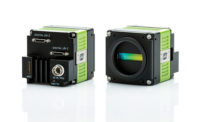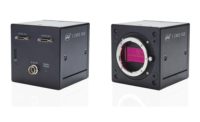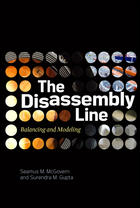Line-Scan Cameras: Harnessing the Power of High-Performance Line-Scan Cameras
Why high-performance, high-speed line-scan cameras are ideal for certain types of applications and how they will perform in these application environments.

High-performance line-scan cameras are used in a variety of demanding industrial inspection applications. These include flat panel display, electronics and solar cell inspection, along with print and postal inspection. The speed, resolution and sensitivity of high-performance line-scan cameras set them apart and make them ideal for certain applications. Color line-scan cameras are also available for applications that require color imaging. First, we’ll take a look at how these cameras work.

Line-scan cameras typically provide for very fast scanning of the pixels so that many pictures may be taken over a short period of time as the object moves in the field of view of the camera. These pictures are then combined by the machine vision system to analyze the picture and perform the inspection.
High-sensitivity line-scan sensors use time delay and integration (TDI) technology; these sensors are built into some line-scan cameras for high-performance image capture. TDI is a method of scanning that provides greater sensitivity than that available from other line scanning methods. This permits much greater scanning speeds with normal lighting or allows reduced lighting levels (and costs) at conventional speeds. The huge advantages in sensitivity provided by TDI (often 100–500 times more sensitive than traditional line scan) allow for truly superior speed and image quality, without the need for expensive, high-power illumination.
Higher speed and higher system throughput
Enabled low-light imaging
More detail with fewer cameras in a multi-camera system, resulting in cost savings
Superb color fidelity

Automated optical inspection (AOI) is the most effective, efficient approach, and manufacturers are moving to 100% inspection of each panel after every major processing step. The goal is to inspect more often, with greater precision, and still reduce the overall time of inspection. AOI is required in flat-panel display production partly because of the industry’s zero-defect policy.
As components and traces shrink, inspection systems need to provide ever-greater resolution while maintaining or even increasing total system throughput-thus the need for speed. Higher speed requires higher sensitivity to make up for the reduced number of photons. Delivering better images in less time with less light presents conflicting goals, but these are the goals inspection systems must meet.

AOI can help in several ways. It allows developers to speed their production process by removing the inspection bottleneck. It also offers higher reliability, precision and accuracy than manual methods. This permits detection of errors earlier in the production process, reducing waste and allows safe handling of thinner wafers while reducing production delays due to wafer breakage and subsequent clean up. The vision systems performing the inspections can also provide immediate feedback on errors detected to support continuous process monitoring and improvement. The result of these benefits is lowered production costs.
Today, automatic inspection and sorting systems are used in many printing works to verify 100% of the final product. Banknotes identified as defective, according to specified parameters, are sorted and removed for destruction.
One of the challenges is the variation in parcel height, which makes it challenging to capture a focused image. Stopping down a lens to give a larger depth of field reduces the amount of light through the aperture, making it hard to capture a clear image at high speed.
High-speed, high-resolution line-scan and TDI cameras enable inspection systems to easily capture barcodes on any parcel. The huge advantages in sensitivity provided by TDI allow superior speed and image quality, even with stopped down lenses, and without the need for expensive, high-power illumination.
When selecting a high-performance line scan camera, make sure the features and benefits of the camera and machine vision system you select are a match for the needs of your application. Look for speed, responsivity, TDI technology and color imaging when needed, along with a high performance to price ratio. V&S
The most common example of line-scan imaging is the fax machine.
Line-scan cameras are ideal for imaging objects at high-speed or for the web inspection of a continuous surface.
Line-scan image capture has many benefits, including higher speed and higher system throughput and superb color fidelity.

When Utechzone’s COBRA AOI system locates and identifies repairable defects, the panel is re-routed for possible repair. In the case of a non-repairable defect, the glass cutting patterns are adjusted to avoid the defects. Source: Teledyne DALSA
High-performance line-scan cameras are used in a variety of demanding industrial inspection applications. These include flat panel display, electronics and solar cell inspection, along with print and postal inspection. The speed, resolution and sensitivity of high-performance line-scan cameras set them apart and make them ideal for certain applications. Color line-scan cameras are also available for applications that require color imaging. First, we’ll take a look at how these cameras work.

For a given field of view, one 2k line-scan camera cost-effectively provides the same resolution as two mega-pixel area scan cameras, without image smear or the redundant processing of frame overlaps. Source: Teledyne DALSA
High-Performance Line-Scan Cameras: What Makes Them Different?
Line scan cameras operate quite differently than area-scan cameras. With an area-scan camera, a matrix of pixels provides a view of an object that contains both length and width. Line-scan imaging uses a single line of pixels to build seamless, two-dimensional images of moving objects. Since the line-scan camera is capturing images one line at a time, the object being scanned is usually moved past the camera and a series of pictures is taken to provide useful data for an inspection. Perhaps the most common example of line-scan imaging is the fax machine.Line-scan cameras typically provide for very fast scanning of the pixels so that many pictures may be taken over a short period of time as the object moves in the field of view of the camera. These pictures are then combined by the machine vision system to analyze the picture and perform the inspection.
High-sensitivity line-scan sensors use time delay and integration (TDI) technology; these sensors are built into some line-scan cameras for high-performance image capture. TDI is a method of scanning that provides greater sensitivity than that available from other line scanning methods. This permits much greater scanning speeds with normal lighting or allows reduced lighting levels (and costs) at conventional speeds. The huge advantages in sensitivity provided by TDI (often 100–500 times more sensitive than traditional line scan) allow for truly superior speed and image quality, without the need for expensive, high-power illumination.
Advantages
Line-scan image capture has many benefits, including:Higher speed and higher system throughput
Enabled low-light imaging
More detail with fewer cameras in a multi-camera system, resulting in cost savings
Superb color fidelity
Trade Offs
The trade-offs in-line scan imaging usually relate to lighting and optics. Illumination must remain reasonably uniform over the entire field of view, although in-camera flat-field correction available on some line-scan cameras can compensate for poor uniformity. Integration times in line-scan imaging are typically very short, so illumination intensity generally needs to be high. However, high-sensitivity TDI line-scan products can address this problem.
Wafer inspection can identify and characterize defects such as micro-cracking before further processing, increasing process yields. Source: Teledyne DALSA
Ideal Applications for High-Performance Line Scan Cameras
Line-scan cameras are ideal for imaging objects at high-speed or for the web inspection of a continuous surface, such as paper, glass or metal. In the applications outlined in the following, manufacturers need to ensure high quality, often with zero defects, but they are also trying to keep costs low.Flat-Panel Display Inspection
Manufacturing flat-panel displays involves precise layering of materials including glass, semiconductors, metals, and polarizing films and subjecting them to many sophisticated etching and electrochemical processing steps. As consumers demand bigger, better TV displays at lower prices, manufacturers must make continual improvement in quality and yield.Automated optical inspection (AOI) is the most effective, efficient approach, and manufacturers are moving to 100% inspection of each panel after every major processing step. The goal is to inspect more often, with greater precision, and still reduce the overall time of inspection. AOI is required in flat-panel display production partly because of the industry’s zero-defect policy.
Electronics Inspection
Electronics inspection applications typically involve AOI at multiple manufacturing stages, from bare printed circuit board inspection to solder paste inspection to populated board inspection (post-reflow), and automated x-ray inspection (AXI). The trend is toward more points of inspection, but the key is always to capture yield-limiting defects, and avoid false positives, while reducing the overall time for inspection.As components and traces shrink, inspection systems need to provide ever-greater resolution while maintaining or even increasing total system throughput-thus the need for speed. Higher speed requires higher sensitivity to make up for the reduced number of photons. Delivering better images in less time with less light presents conflicting goals, but these are the goals inspection systems must meet.

Solar Cell Inspection
Governments, private industry and consumers are all seeking energy sources that are “greener” but still affordable, and as a result, solar cell manufacturers are under pressure to increase the quality of their products and reduce costs. Yield is critical, and optical inspection is an important tool. Much like flat-panel display manufacturers, solar cell manufacturers are moving to 100% inspection of each panel after every major processing step.AOI can help in several ways. It allows developers to speed their production process by removing the inspection bottleneck. It also offers higher reliability, precision and accuracy than manual methods. This permits detection of errors earlier in the production process, reducing waste and allows safe handling of thinner wafers while reducing production delays due to wafer breakage and subsequent clean up. The vision systems performing the inspections can also provide immediate feedback on errors detected to support continuous process monitoring and improvement. The result of these benefits is lowered production costs.
Print Inspection
Print inspection systems are an excellent fit for high-performance line-scan cameras. One interesting type of print inspection is the inspection of banknotes. Traditionally, banknote quality has largely been determined by means of manual visual inspection. By definition, this check focused on the visible aspects of the product and was also influenced by human subjectivity and lack of consistency.Today, automatic inspection and sorting systems are used in many printing works to verify 100% of the final product. Banknotes identified as defective, according to specified parameters, are sorted and removed for destruction.
Postal and Parcel Inspection
Automation is vital to modern postal and parcel sorting. While bar codes have simplified scanning in the retail environment, postal sorting equipment must deal with much more challenging conditions and targets. Postal and parcel inspection systems typically still lift an image of an entire address (possibly handwritten) from letters, magazines, and parcels and use sophisticated algorithms to interpret it and automatically send the item down the correct path. High-speed, high-resolution line-scan cameras enable systems to easily capture barcodes on any parcel.One of the challenges is the variation in parcel height, which makes it challenging to capture a focused image. Stopping down a lens to give a larger depth of field reduces the amount of light through the aperture, making it hard to capture a clear image at high speed.
High-speed, high-resolution line-scan and TDI cameras enable inspection systems to easily capture barcodes on any parcel. The huge advantages in sensitivity provided by TDI allow superior speed and image quality, even with stopped down lenses, and without the need for expensive, high-power illumination.
Summary
Automated optical inspection will continue to play a critical role in industrial inspection. With the help of high-performance line scan cameras, AOI serves as an enabler for the cost-effective manufacture of complex flat-panel display and solar panels and electronic components. The benefits of high-performance line scan cameras also help increase inspection yield without compromising production throughput for the print and postal industries.When selecting a high-performance line scan camera, make sure the features and benefits of the camera and machine vision system you select are a match for the needs of your application. Look for speed, responsivity, TDI technology and color imaging when needed, along with a high performance to price ratio. V&S
Tech Tips
Line-scan imaging uses a single line of pixels to build seamless, two-dimensional images of moving objects.The most common example of line-scan imaging is the fax machine.
Line-scan cameras are ideal for imaging objects at high-speed or for the web inspection of a continuous surface.
Line-scan image capture has many benefits, including higher speed and higher system throughput and superb color fidelity.
Looking for a reprint of this article?
From high-res PDFs to custom plaques, order your copy today!









